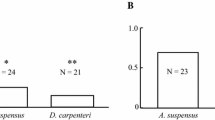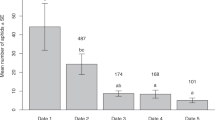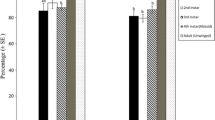Abstract
The solitary parasitoids Aphidius erviHaliday (Hymenoptera: Aphidiidae) and Aphelinus asychisWalker (Hymenoptera: Aphelinidae) attacked but generally did not oviposit in pea aphids parasitized by the other species. Wasps selectively oviposited in unparasitized hosts when given a choice. Host discrimination depended on the recognition of internal cues. Females of A. asychiseither could not recognize or ignored A. ervi'sexternal host marking pheromone. Under most conditions, A. ervisurvived in superparasitized hosts, killing competing A. asychislarvae by physical attack and possibly physiological suppression. The outcome of larval competition was not affected by oviposition sequence or age difference between larvae; A. asychissurvived only when it had substantially completed larval development before the host was superparasitized by A. ervi.It is suggested that competition for host resources incurs a cost, for the winner in terms of reduced size or increased development time and for the loser in terms of lost progeny and searching time. Consequently, heterospecific host discrimination can be functional. Internal, and probably general, cues enable wasps to recognize and avoid oviposition in hosts already parasitized by an unrelated species.
Similar content being viewed by others
References
Bai, B., and Mackauer, M. (1990a). Host discrimination by the aphid parasitoidAphelinus asychis (Hymenoptera: Aphelinidae): When superparasitism is not adaptive.Can. Entomol. 122: 363–372.
Bai, B., and Mackauer, M. (1990b). Oviposition and host-feeding patterns byAphelinus asychis (Hymenoptera: Aphelinidae) at different aphid densities.Ecol. Entomol. 15: 9–16.
Bakker, K., van Alphen, J. J. M., van Batenburg, F. H. D., van der Hoeven, N., Nell, H. W., van Strien-van Liempt, W. F. T. H., and Turlings, T. C. J. (1985). The function of host discrimination and superparasitism in parasitoids.Oecologia 67: 572–576.
Beard, R. L. (1972). Effectiveness of paralyzing venom and its relation to host discrimination by braconid wasps.Ann. Entomol. Soc. Am. 65: 90–93.
Beckage, N. E., and Templeton, T. J. (1986). Physiological effects of parasitism byApanteles congregatus in terminal-stage tobacco hornworm larvae.J. Insect Physiol. 32: 299–314.
Bosque, C., and Rabinovich, J. E. (1979). Population dynamics ofTelenomus fariai (Hymenoptera: Scelionidae), a parasite of Chagas' disease vectors. VII. Oviposition behavior and host discrimination.Can. Entomol. 111: 171–180.
Boyle, H., and Barrows, E. M. (1978). Oviposition and host feeding behavior ofAphelinus asychis (Hymenoptera: Chalcidoidea: Aphelinidae) onSchizaphis graminum (Homoptera: Aphididae) and some reactions of aphids to this parasite.Proc. Entomol. Soc. Wash. 80: 441–455.
Calvert, D. J., and van den Bosch, R. (1972). Behaviour and biology ofMonoctonus paulensis (Hymenoptera: Braconidae), a parasite of dactynotine aphids.Ann. Entomol. Soc. Am. 65: 773–779.
Chow, F. J., and Mackauer, M. (1986). Host discrimination and larval competition in the aphid parasiteEphedrus californicus.Entomol. Exp. Appl. 41: 243–254.
Cloutier, C. (1986). Amino acid utilization in the aphidAcyrthosiphon pisum infected by the parasitoidAphidius smithi.J. Insect Physiol. 32: 263–267.
Cloutier, C., and Mackauer, M. (1979). The effect of parasitism byAphidius smithi (Hymenoptera: Aphidiidae) on the food budget of the pea aphid,Acyrthosiphon pisum (Homoptera: Aphididae).Can. J. Zool. 57: 1605–1611.
Fisher, R. C. (1971). Aspects of the physiology of endoparasitic Hymenoptera.Biol. Rev. 46: 243–278.
Force, D. C., and Messenger, P. S. (1965). Laboratory studies on competition among three parasites of the spotted alfalfa aphidTherioaphis maculata (Buckton).Ecology 46: 853–859.
Gardner, S. M., Ward, S. A., and Dixon, A. F. G. (1984). Limitation of superparasitism byAphidius rhopalosiphi: A consequence of aphid defensive behaviour.Ecol. Entomol. 9: 149–155.
Gerling, D., Roitberg, B. D., and Mackauer, M. (1990). Instar-specific defense of the pea aphid,Acyrthosiphon pisum: Influence on oviposition success of the parasiteAphelinus asychis (Hymenoptera: Aphelinidae).J. Insect Behav. 3: 501–514.
Hartley, E. A. (1922). Some bionomics ofAphelinus semiflavus (Howard) chalcid parasite of aphids.Ohio J. Sci. 22: 209–236.
Hawlitzky, N., and Boulay, C. (1986). Effects of the egg-larval parasite,Phanerotoma flavitestacea Fisch. (Hymenoptera, Braconidae) on the dry weight and chemical composition of its hostAnagasta kuehniella Zell. (Lepidoptera, Pyralidae).J. Insect Physiol. 32: 269–274.
Hofsvang, T. (1988). Mechanisms of host discrimination and intraspeciflc competition in the aphid parasitoidEphedrus cerasicola.Entomol. Exp. Appl. 48: 233–239.
Hofsvang, T., and Hågvar, E. B. (1986). Oviposition behaviour ofEphedrus cerasicola (Hym: Aphidiidae) parasitizing different instars of its aphid host.Entomophaga 31: 261–267.
Hubbard, S. F., Marris, G., Reynolds, A., and Rowe, G. W. (1987). Adaptive patterns in the avoidance of superparasitism by solitary parasitic wasps.J. Anim. Ecol. 56: 387–403.
Jones, D. (1985). The endocrine basis for developmentally stationary prepupae in larvae ofTrichoplusia ni pseudoparasitized byChelonus insularis.J. Comp. Physiol. 155: 235–240.
Jones, D., Jones, G., Rudnicka, M., Click, A., Reck-Malleczewen, V., and Iwaya, M. (1986). Pseudoparasitism of hostTrichoplusia ni byChelonus spp. as a new model system for parasite regulation of host physiology.J. Insect Physiol. 32: 315–328.
Mackauer, M. (1972). Antennal amputation as a method for bio-marking aphids.J. Econ. Entomol. 65: 1725–1727.
Mackauer, M. (1990). Host discrimination and larval competition in solitary endoparasitoids. In Mackauer, M., Ehler, L. E., and Roland, J. (eds.),Critical Issues in Biological Control, Intercept, Andover, Hants., pp. 41–62.
Mackauer, M., and Chow, F. J. (1986). Parasites and parasite impact. In McLean, G. D., Garrett, R. G., and Ruesink, W. G. (eds.),Plant Virus Epidemics: Monitoring, Modelling and Predicting Outbreaks, Academic Press, Sydney, pp. 95–118.
Mackauer, M., and Chow, F. J. (1990). The effect of stinging: Aphidiid parasitoids (Hymenoptera) “prefer” pseudoparasitized pea aphids.Mitt. Schweiz. Entomol. Ges. (in press).
McBrien, H., and Mackauer, M. (1990). Heterospecific larval competition and host discrimination in two species of aphid parasitoids:Aphidius ervi andAphidius smithi.Entomol. Exp. Appl. 56: 145–153.
McBrien, H., and Mackauer, M. (1991). Decision to superparasitize based on larval survival: Competition between aphid parasitoidsAphidius ervi andAphidius smithi. Entomol. Exp. Appl. (in press).
Price, P. W. (1970). Trail odors: Recognition by insects parasitic on cocoons.Science 170: 546–547.
Rabb, R. L., and Bradley, J. R. (1970). Marking host eggs byTelenomus sphingis.Ann. Entomol. Soc. Am. 63: 1053–1056.
Salt, G. (1937). The sense used byTrichogramma to distinguish between parasitized and unparasitized hosts.Proc. Roy. Soc. Lond. B 122: 57–75.
Sokal, R. R., and Rohlf, F. J. (1981).Biometry, 2nd ed., W. H. Freeman, San Francisco, CA.
Stoltz, D. B. (1986). Interactions between parasitoid-derived products and host insects: An overview.J. Insect Physiol. 32: 347–350.
Strand, M. R. (1986). Physiological interactions of parasitoids with their hosts and their influence on reproductive strategies. In Waage, J., and Greathead, D. (eds.),Insect Parasitoids, Academic Press, London, pp. 97–136.
Sugimoto, T., Uenichi, M., and Machida, F. (1986). Foraging for patchily-distributed leaf-miners by the parasitoid,Dapsilarthra rufiventris (Hymenoptera: Braconidae). I. Discrimination of previously searched leaflets.Appl. Entomol. Zool. 21: 500–508.
Takasu, K., and Hirose, Y. (1988). Host discrimination in the parasitoidOoencyrtus nezarae: The role of the egg stalk as an external marker.Entomol. Exp. Appl. 47: 45–48.
Thompson, S. N. (1986). Effect of the insect parasiteHyposoter exiguae (Viereck) on the carbohydrate metabolism of its host,Trichoplusia ni (Hubner).J. Insect Physiol. 32: 287–293.
Turlings, T. J. C., van Batenburg, F. D. H., and van Strien-van Liempt, W. T. F. H. (1985). Why is there no interspecific host discrimination in the two coexisting larval parasitoids ofDrosophila species;Leptopilina heterotoma (Thomson) andAsobara tabida (Nees).Oecologia 67: 352–359.
van Alphen, J. J. M. (1988). Patch time allocation by insect parasitoids: Superparasitism and aggregation. In de Jong, G. (ed.).Population Genetics and Evolution, Springer Verlag, Berlin, pp. 215–221.
van Alphen, J. J. M., and Visser, M. E. (1990). Superparasitism as an adaptive strategy for insect parasitoids.Annu. Rev. Entomol. 35: 59–79.
van Lenteren, J. C. (1981). Host discrimination by parasitoids. In Nordlund, D. A., Jones, R. L., and Lewis, W. J. (eds.),Semiochemicals: Their Role in Pest Control, Wiley-Interscience, New York, pp. 153–179.
van Strien-van Liempt, W. T. F. H., and van Alphen, J. J. M. (1981). The absence of interspecific host discrimination inAsobara tabida Nees andLeptopilina heterotoma (Thomson), coexisting larval parasitoids ofDrosophila species.Neth. J. Zool. 31: 701–712.
Vet, L. E. M., Meyer, M., Bakker, K., and van Alphen, J. J. M. (1984). Intra- and interspecific host discrimination inAsobara (Hymenoptera) larval endo-parasitoids of Drosophilidae: Comparison between closely related and less closely related species.Anim. Behav. 32: 871–874.
Visser, M. E., van Alphen, J. J. M., and Nell, H. W. (1990). Adaptive superparasitism and patch time allocation in solitary parasitoids: The influence of the number of parasitoids depleting a patch.Behavior 114: 21–36.
Völkl, W., and Mackauer, M. (1990). Age-specific pattern of host discrimination by the aphid parasitoidEphedrus californicus Baker (Hymenoptera: Aphidiidae).Can. Entomol. 122: 349–361.
Wilbert, H. (1964). Das Ausleseverhalten vonAphelinus semiflavus Howard und die Abwehrreaktionen seiner Wirte.Beitr. Entomol. 14: 159–219.
Author information
Authors and Affiliations
Rights and permissions
About this article
Cite this article
Bai, B., Mackauer, M. Recognition of heterospecific parasitism: Competition between Aphidiid (Aphidius ervi) and Aphelinid (Aphelinus asychis) parasitoids of Aphids (Hymenoptera: Aphidiidae; Aphelinidae). J Insect Behav 4, 333–345 (1991). https://doi.org/10.1007/BF01048282
Accepted:
Issue Date:
DOI: https://doi.org/10.1007/BF01048282




